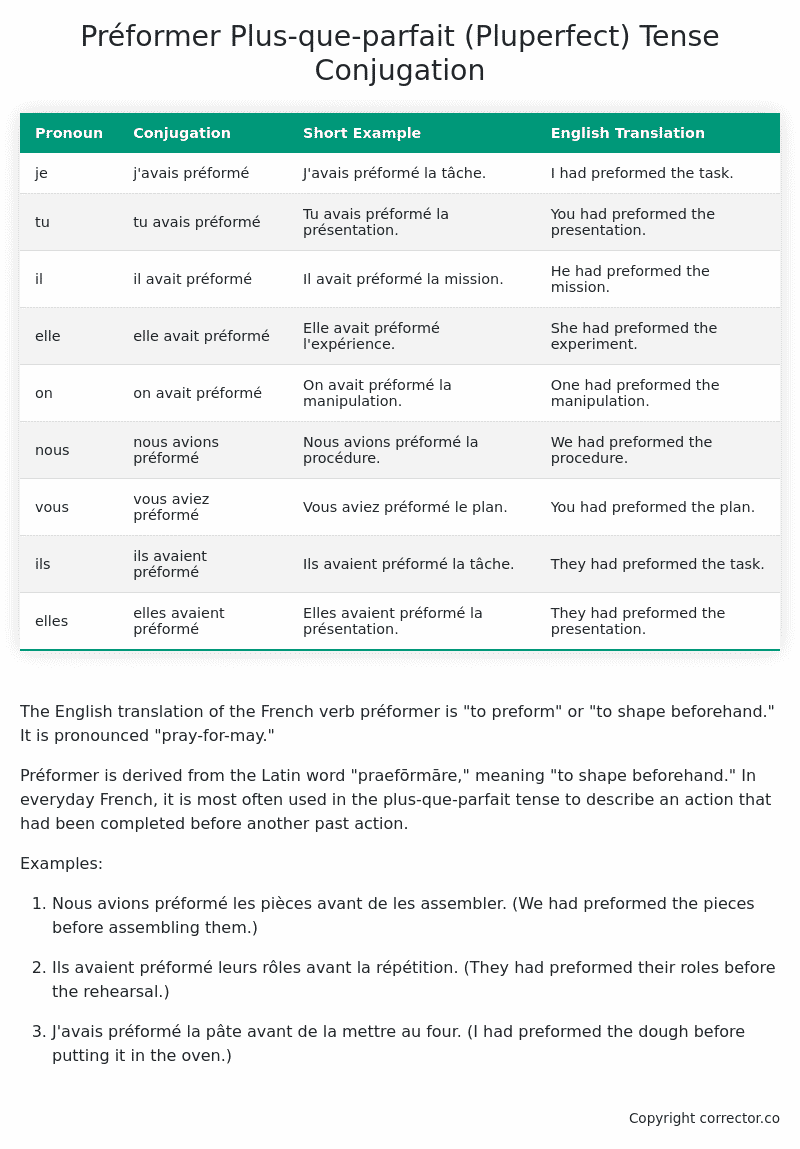Plus-que-parfait (Pluperfect) Tense Conjugation of the French Verb préformer
Introduction to the verb préformer
The English translation of the French verb préformer is “to preform” or “to shape beforehand.” It is pronounced “pray-for-may.”
Préformer is derived from the Latin word “praefōrmāre,” meaning “to shape beforehand.” In everyday French, it is most often used in the plus-que-parfait tense to describe an action that had been completed before another past action.
Examples:
-
Nous avions préformé les pièces avant de les assembler. (We had preformed the pieces before assembling them.)
-
Ils avaient préformé leurs rôles avant la répétition. (They had preformed their roles before the rehearsal.)
-
J’avais préformé la pâte avant de la mettre au four. (I had preformed the dough before putting it in the oven.)
Table of the Plus-que-parfait (Pluperfect) Tense Conjugation of préformer
| Pronoun | Conjugation | Short Example | English Translation |
|---|---|---|---|
| je | j’avais préformé | J’avais préformé la tâche. | I had preformed the task. |
| tu | tu avais préformé | Tu avais préformé la présentation. | You had preformed the presentation. |
| il | il avait préformé | Il avait préformé la mission. | He had preformed the mission. |
| elle | elle avait préformé | Elle avait préformé l’expérience. | She had preformed the experiment. |
| on | on avait préformé | On avait préformé la manipulation. | One had preformed the manipulation. |
| nous | nous avions préformé | Nous avions préformé la procédure. | We had preformed the procedure. |
| vous | vous aviez préformé | Vous aviez préformé le plan. | You had preformed the plan. |
| ils | ils avaient préformé | Ils avaient préformé la tâche. | They had preformed the task. |
| elles | elles avaient préformé | Elles avaient préformé la présentation. | They had preformed the presentation. |
Other Conjugations for Préformer.
Le Present (Present Tense) Conjugation of the French Verb préformer
Imparfait (Imperfect) Tense Conjugation of the French Verb préformer
Passé Simple (Simple Past) Tense Conjugation of the French Verb préformer
Passé Composé (Present Perfect) Tense Conjugation of the French Verb préformer
Futur Simple (Simple Future) Tense Conjugation of the French Verb préformer
Futur Proche (Near Future) Tense Conjugation of the French Verb préformer
Plus-que-parfait (Pluperfect) Tense Conjugation of the French Verb préformer (this article)
Passé Antérieur (Past Anterior) Tense Conjugation of the French Verb préformer
Futur Antérieur (Future Anterior) Tense Conjugation of the French Verb préformer
Subjonctif Présent (Subjunctive Present) Tense Conjugation of the French Verb préformer
Subjonctif Passé (Subjunctive Past) Tense Conjugation of the French Verb préformer
Subjonctif Imparfait (Subjunctive Imperfect) Tense Conjugation of the French Verb préformer
Subjonctif Plus-que-parfait (Subjunctive Pluperfect) Tense Conjugation of the French Verb préformer
Conditionnel Présent (Conditional Present) Tense Conjugation of the French Verb préformer
Conditionnel Passé (Conditional Past) Tense Conjugation of the French Verb préformer
L’impératif Présent (Imperative Present) Tense Conjugation of the French Verb préformer
L’infinitif Présent (Infinitive Present) Tense Conjugation of the French Verb préformer
Struggling with French verbs or the language in general? Why not use our free French Grammar Checker – no registration required!
Get a FREE Download Study Sheet of this Conjugation 🔥
Simply right click the image below, click “save image” and get your free reference for the préformer Plus-que-parfait tense conjugation!

Préformer – About the French Plus-que-parfait (Pluperfect) Tense
Tense Formation
Common everyday usage patterns
Sequencing of past events
Background information
Hypothetical or reported speech
Interactions with other tenses
Summary
I hope you enjoyed this article on the verb préformer. Still in a learning mood? Check out another TOTALLY random French verb conjugation!


